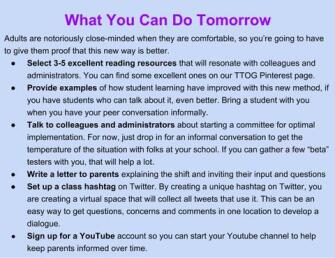
The way we grade is deeply personal and also deeply embedded in a traditional system that begs for numbers and letters. Because most folks who have gone through an American system at some point in their lives have been graded this way and simply don’t know there are alternatives.
In fact, we often stay with what we know even though we may concede that it isn’t best for students. Most teachers HATE grading. They loathe it. It stirs negative feelings because putting a single letter or number any child’s work diminishes the process it took to get there.
That being said, even though educators may know it on in the inside, we still work in institutions that largely don’t subscribe to straying from the norm and we work with and for people who don’t understand the nuances of assessing learning.
Depending on what age group you teach, it is likely your students have been in this system that almost demands a final score. They don’t know any better either and are trained to look for this indicator to understand their learning.
As you consider making this important leap, there are ways that you can help the folks in your school, community, and classroom understand why and how it will improve learning to do assessment differently.
Although the following list of what you can do tomorrow (which comes from Hacking Assessment) isn’t the only way to go about involving stakeholders, it will be an entry point for building a foundation for a larger discussion.
What You Can Do Tomorrow
Adults are notoriously close-minded when they are comfortable, so you’re going to have to give them proof that this new way is better.
Select 3-5 excellent reading resources that will resonate with colleagues and administrators. You can find some excellent ones on our TTOG Pinterest page. Consider joining the Facebook pages that champion this method of assessment as well: Teachers Throwing Out Grades and T2G (Teachers Going Gradeless). There are other groups as well, like the SBG page where experts and other people who are in various stages of the process share their ideas, experiences, and challenges and work together to problem solve.
Provide examples of how student learning has improved with this new method, if you have students who can talk about it, even better. Bring a student with you when you have your peer conversation informally.
Talk to colleagues and administrators about starting a committee for optimal implementation. For now, just drop in for an informal conversation to get the temperature of the situation with folks at your school. If you can gather a few “beta” testers with you, that will help a lot.
Write a letter to parents explaining the shift and inviting their input and questions
- Set up a class hashtag on Twitter. By creating a unique hashtag on Twitter, you are creating a virtual space that will collect all tweets that use it. This can be an easy way to get questions, concerns, and comments in one location to develop a dialogue.
- Sign up for a YouTube account so you can start your Youtube channel to help keep parents informed over time.
These tips will help you start the conversation and will help you build a more transparent experience that can aid in easing tensions and concerns about learning and assessment in your classrooms and schools. There will be more work that needs to be done and on-going conversations will need to happen but don’t give up.
As we consider what is best for students, we must remember that they are more than a number. Let’s provide them with the feedback they need to progress, the language they need to reflect on learning and the strategies to keep growing. Always keeping mastery in mind, students will meet and exceed expectations the more we bring them into that specific conversation.
How can you start to shift this conversation in your school community? Please share